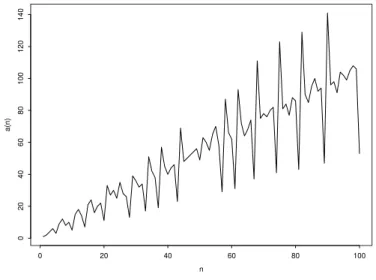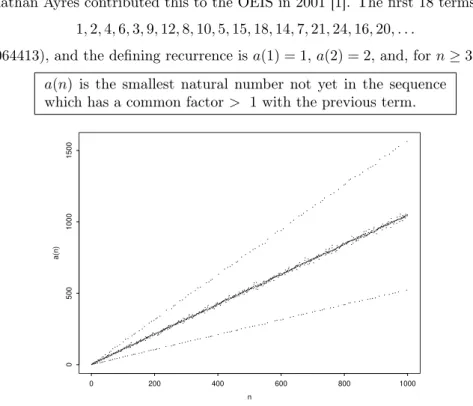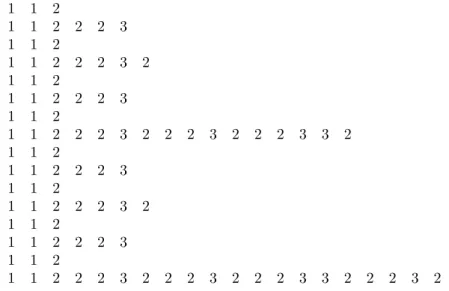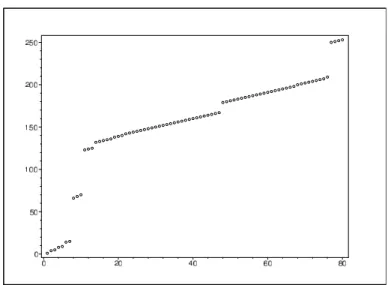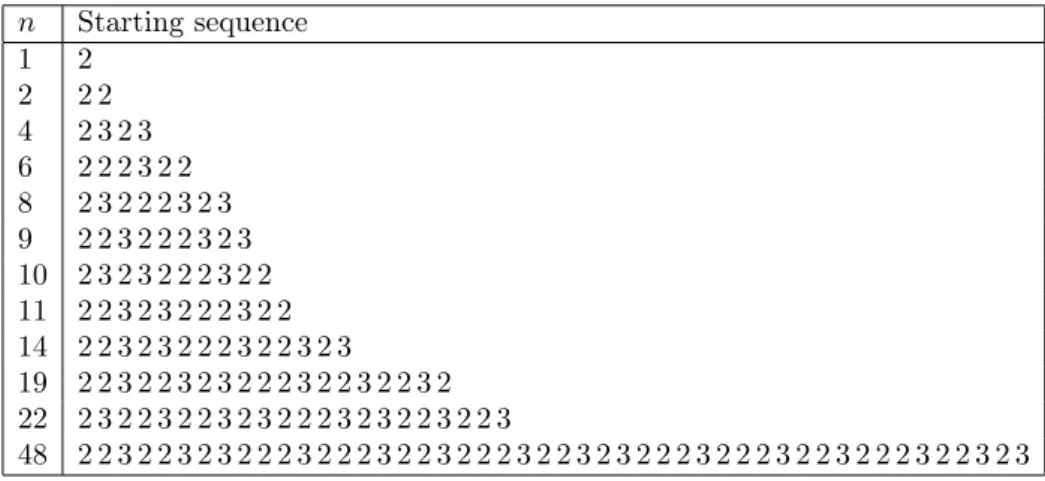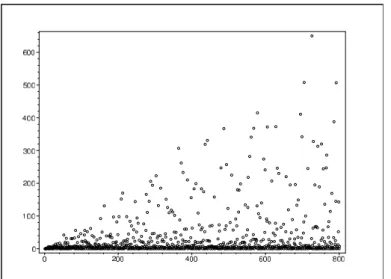The On-Line Encyclopedia of Integer Sequences
N. J. A. Sloane
The OEIS Foundation Inc., USA njasloane@gmail.com
Abstract
We all recognize0,1,1,2,3,5,8,13, . . .but what about1,2,4,6,3,9,12,8, 10,5,15, . . .? If you come across a number sequence and want to know if it has been studied before, there is only one place to look, theOn-Line Encyclopedia of Integer Sequences (or OEIS). Now in its 49th year, the OEIS contains over 220,000 sequences and 20,000 new entries are added each year. This article will briefly describe the OEIS and its history. It will also discuss some sequences generated by recurrences that are less familiar than Fibonacci’s, due to Greg Back and Mihai Caragiu, Reed Kelly, Jonathan Ayres, Dion Gijswijt, and Jan Ritsema van Eck.
Keywords: Fibonacci, sequences, recurrences.
MSC: Primary 11B
1. The Fibonacci numbers
The Fibonacci numbers have been in the On-Line Encyclopedia of Integer Se- quencesR (or OEISR) right from the beginning. When I started collecting se- quences as a graduate student in 1964, the Fibonacci numbers became sequence A000045 (incidentally, 49 years later, sequences being added have A-numbers around A2220001). Over 3000 sequences in the OEIS mention Fibonacci’s name in their definition.
Some especially noteworthy variations on the Fibonacci numbers were recently defined by Back and Caragiu [2] in theFibonacci Quarterly. The simplest of their
1As of February 2013. Throughout this article, six-digit numbers prefixed by A refer to entries in the OEIS [15]. As in the OEIS, we adopt the convention thata(n)denotes thenth term of the sequence being discussed.
Proceedings of the
15thInternational Conference on Fibonacci Numbers and Their Applications Institute of Mathematics and Informatics, Eszterházy Károly College
Eger, Hungary, June 25–30, 2012
219
examples replaces the Fibonacci recurrence by
a(n) = gpf(a(n−1) +a(n−2)), (1.1)
wheregpf stands forgreatest prime factor(A006530). If we start with1,1we get 1,1,2,3,5,2,7,3,5,2,7, . . . (1.2) (A175723), and the cycle3,5,2,7repeats for ever. Back and Caragiu show that no matter what the initial values are, (1.1) always becomes periodic and that3,5,2,7 is the only nontrivial cycle. On the other hand, consider
a(n) = gpf(a(n−1) +a(n−2) +a(n−3)). (1.3) If we start with1,1,1 we get
1,1,1,3,5,3,11,19,11,41,71,41,17,43,101,23, . . . (1.4) (A177904), which after 86 steps enters a cycle of length 212. Now it is only a conjecture that (1.3) always becomes periodic, for any initial values.
Another interesting variant of the Fibonacci sequence2was very recently intro- duced into the OEIS by Reed Kelly [12]. Kelly’s recurrence is
a(n) = a(n−1) +a(n−3)
gcd{a(n−1), a(n−3)}, (1.5) with initial values1,1,1:
1,1,1,2,3,4,3,2,3,2,2,5,7,9,14,3,4,9,4,2, . . . (1.6) (A214551). This sequence appears to grow exponentially (a(n)≈const.·e0.123...n?), but essentially nothing has been proved about it.
The OEIS is an endless source of lovely problems!
2. How the OEIS is used
However, the main use for the OEIS is as a reference work for identifying sequences and telling you what is known about them. If you come across a sequence of numbers, and you want to know if it has been studied before, there is only one place to look, the OEIS [15] (http://oeis.org).
You enter the first few terms3, and click “Submit”. If you are lucky, the OEIS will return one or more sequences that match what you entered, and, for each one, it will tell you such things as:
2Or, more precisely, of another medieval sequence, the Narayana cows sequence, A000930.
3When looking up a sequence, it is recommended that you omit the first term or two, since different people may start a sequence in different ways.
– The definition of the sequence
– The first 10, or 10,000, or sometimes 500,000 terms – Comments explaining further properties of the sequence – Formulas for generating the sequence
– Computer programs for producing the sequence
– References to books and articles where the sequence is mentioned – Links to web pages on the Internet where the sequence has appeared – The name of the person who submitted the sequence to the OEIS
– Examples illustrating some of the terms of the sequence (for example, se- quence A000124, which gives the maximal number of pieces that can be obtained when cutting a circular pancake with n cuts, is illustrated with pictures showing the pieces obtained with 1, 2, 3, 4 and 5 cuts)
– The history of each entry in the OEIS as it has evolved over time
You can also view graphs or plots of the sequence, or listen to it when it is converted to sounds.
If your sequence is not found, you will be encouraged to submit it. This will establish your priority over the sequence, and will help the next person who comes across it. Only sequences of general interest should be submitted. The sequence of primes whose decimal expansion begins with 2012 is an example of a sequence that would not be of general interest. Published sequences are almost always acceptable.
If your sequence was not in the OEIS, you should also try sending it to our email serverSuperseeker(seehttp://oeis.org/ol.html), which will try hard to find an explanation for your sequence. For example, Superseeker might suggest a recurrence or generating function for your sequence, or tell you that it can be obtained by applying one of over a hundred different transformations to one of the over 200,000 sequences in the OEIS. Superseeker is a very powerful tool for analyzing sequences.
Accuracy has always been one of the top priorities in the OEIS. Its standards are those of a mathematics reference work. Ideally, every number, formula, computer program, etc., should be absolutely correct. Formulas that are stated uncondi- tionally should be capable of being proved, and otherwise should be labeled as conjectures. Of course, as the database has grown, these goals have become harder and harder to achieve. Many non-mathematicians have difficulty in understanding the difference between a theorem and a conjecture. (“My formula fits the first 30 terms, so obviously itmust be correct.”)
The OEIS has often been called one of the most useful mathematical sites on the Internet. There is a web page (http://oeis.org/wiki/Works\_Citing\_OEIS) that lists over 3000 articles and books that reference it.
3. History of the OEIS
I started collecting sequences in 1964, entering them on punched cards (the original motivation was to find an explanation for various sequences that had arisen in my dissertation, the simplest of which was the sequence that became A000435).
Eventually two books were published ([16] in 1973, with 2372 entries, and [17], written with Simon Plouffe, in 1995, with 5847 sequences).
In 1996, when the number of entries had risen to 10,000, I put the database on the Internet, calling it the The On-Line Encyclopedia of Integer Sequences or OEIS. By 2009, the database had grown to over 150,000 entries, and was becoming too big for one person to manage, so I set up a foundation,The OEIS Foundation Inc (http://oeisf.org), whose goals are to own the intellectual property of the OEIS, to maintain it, and to raise funds to support it.
With major help from Russ Cox (of Google) and my colleague David Applegate (at AT&T), I moved the OEIS off my home page at AT&T to a commercial hosting service, and attempted to set it up as a “wiki.” However, this proved to be extremely difficult, and it required a tremendous amount of work by Russ Cox before it started working properly. It was not until November 11, 2010 that the OEIS was officially launched in its new home athttp://oeis.org. This would not have been possible without the help that Russ Cox and David Applegate provided.
The fact that the OEIS is now a wiki means that I no longer have to process all the updates myself. Once a user has registered4, he or she can propose new sequences or updates to existing sequences. All submissions are reviewed by a panel of about 80 editors. Nearly two years after it was launched, the wiki system is working well. Since November 2010 the database has grown from 180,000 sequences to its current number of around 220,000. From 1996 to the present, the database has grown at between 10,000 and 20,000 new sequences per year, with about an equal number of entries that are updated.
More about the history of the OEIS can be found on the OEIS Foundation web site,http://oeisf.org.5
4. The poster and the OEIS movie
To celebrate the creation of the the OEIS Foundation, David Applegate and I made a poster that shows 25 especially interesting sequences (several of which will be mentioned in this article). It can be downloaded (along with a key) from the Foundation web site.
Also, Tony Noe made a movie that shows graphs of the first thousand terms of a thousand sequences from the OEIS: it is quite spectacular. It runs for 8.5 minutes,
4All readers are encouraged to register: go tohttp://oeis.org/wikiand click “Register.”
5As President, it would be remiss of me not to mention that the OEIS Foundation is a charitable organization and donations are tax-deductible in the USA. The web site is free, and none of the trustees receive a salary. To make a donation, please go tohttp://oeisf.org.
and it too can be found on the Foundation web site. It is also on YouTube (search for “OEIS movie”).
5. Puzzles
One of the goals of the OEIS has always been to help people get higher scores on IQ tests, and the database includes many sequences that have appeared as puzzles.
The following are a few examples. If you can’t solve them, you know where to find the answers!
• 61, 21, 82, 43, . . .
• 2, 4, 6, 30, 32, 34, 36, 40, 42, 44, 46, 50, 52, 54, 56, 60, 62, 64, 66, 2000, . . .
• 0, 0, 0, 0, 4, 9, 5, 1, 1, 0, 55, 55, . . .
• 5, 8, 12, 18, 24, 30, 36, 42, 52, 60, . . .
• 1, 2, 6, 21, 85, 430, 2586, 18109, 144880, . . .
The last one is a bit tricky, but it did appear on a quiz.
6. Two sequences that agree for a long time
People often ask if it is possible for two sequences to agree for many terms yet not be the same. Here is an extreme example. The sequences
2n log 2
and 2
21/n−1
both begin
2,5,8,11,14,17,20,23,25,28,31,34,37, . . .
(A078608). In fact they agree for the first 777451915729367 terms! There are infinitely many disagreements, the positions of which form sequence A129935:
777451915729368,140894092055857794,1526223088619171207,3052446177238342414, . . .
7. Theorems resulting from the OEIS
Another question that is often asked is if there are any theorems that have resulted from the OEIS. The answer is that there are many such examples. In the list of papers that cite the OEIS (http://oeis.org/wiki/Works\_Citing\_OEIS) one will find numerous acknowledgments that say things like “This result was discovered with the help of the OEIS.”
I will give three concrete examples of theorems that were discovered with the help of the OEIS. The first concerns the remainder term in Gregory’s series for π/2,
π 2 = 2
X∞ k=1
(−1)k+1 2k+ 1 = 2
1−1 3+1
5 −1 7 +· · ·
, (7.1)
which is famous for converging very slowly. In 1987, Joseph North observed that if one truncates the series after 50,000 terms, the answer is of course wrong. There is an error in the fifth decimal place. Surprisingly, he noticed that the next nine digits are correct, then there is an error, then there are nine more correct digits, another error, and so on. Here is the decimal expansion of the truncated sum followed by the true value of π/2 (the sequences of digits form A013706 and A019669). The digits that differ are in bold-face.
1.570796326794896619231321691639751442098584699687. . . (truncated) 1.570786326794897619231321191639752052098583314687. . . (true value) The differences between the corresponding bold-faced terms are
1,−1,5,−61,1385, . . . .
Jonathan Borwein looked up this sequence in [16], and found that (apart from signs) it appeared to be the Euler numbers, A000364. The end result of this investigation was a new theorem.
Theorem 7.1 (Borwein, Borwein and Dilcher [4]; see also [3, pp. 28–29], [5]).
π 2 −2
N/2X
k=1
(−1)k+1 2k+ 1 ∼
X∞ m=0
Em
N2m+1, (7.2)
where theEm are the Euler numbers (A000364):
1,1,5,61,1385,50521,2702765,199360981,19391512145, . . . .
The second example is one that I was involved with personally. It began when Eric W. Weisstein (at Wolfram Research, and creator of MathWorld) wrote to me about a discovery he had made. He had been classifying real matrices of 0’s and 1’s according to various properties, and he found that the numbers of such matrices all of whose eigenvalues were positive were1,3,25,543,29281for matrices of orders1,2, . . . ,5. He observed that these numbers coincided with the beginning of sequence A003024 (whose definition on the surface seemed to have nothing to do with eigenvalues), and he conjectured that the sequences should in fact be identical.
He was right, and this led to the following theorem.
Theorem 7.2([14]). The number of acyclic directed graphs withnlabeled vertices is equal to the number ofn×nmatrices of0’s and1’s all of whose eigenvalues are real and positive.
The third example is a result of Deutsch and Sagan [8]. It is well-known that the famous Catalan numbers
Cn:= 1 n+ 1
2n n
(A000108) are odd if and only ifn= 2k−1for somek. Deutsch and Sagan proved (among other things) an analogous result for the almost equally-famous Motzkin numbers (A001006),
Mn :=
Xn
k=1
n 2k
Ck.
Theorem 7.3 ([8]). Mn is even if and only ifn∈4S−2 or4S−1, where S:= (1,3,4,5,7,9,11,12,13,15, . . .)
lists the numbers whose binary expansion ends with an even number of 0’s (A003159).
8. Three unusual recurrences
The Fibonacci recurrence is very nice, but it is 800 years old. In the last section of this article I will discuss somemodern recurrences that I find very appealing.
8.1. The EKG sequence
n
a(n)
0 20 40 60 80 100
020406080100120140
Figure 1: The first 100 terms of the EKG sequence, with successive points joined by lines
n
a(n)
800 850 900 950 1000
4006008001000120014001600
Figure 2: Terms 800 to 1000 of the EKG sequence
Jonathan Ayres contributed this to the OEIS in 2001 [1]. The first 18 terms are 1,2,4,6,3,9,12,8,10,5,15,18,14,7,21,24,16,20, . . .
(A064413), and the defining recurrence isa(1) = 1, a(2) = 2, and, forn≥3, a(n) is the smallest natural number not yet in the sequence which has a common factor> 1with the previous term.
.......................... ....
. ....
. ....
. ....
. . ...
. . ...
. . .....
. . ....
. . ..
. . ...
. . ...
. . ...
. . ...
. . ...
. . ...
. . ....
. . ..
. . ...
. . ......
. . .......
. . ....
. . ...
. . ......
. . ...
. . .....
. . ...
. . .......
. . ...
. .
...
. .
...
. .
......
. .
......
. .
....
. .
..
. .
......
. .
.......
. .
...
. .
......
. .
....
. .
...
. .
..
. .
...
. .
...
. .
.......
. .
...
. .
.... .
. .
.... ...
. .
...
. .
...
. .
...
. .
......
. .
....
. .
...
. .
...
. .
..........
. .
...
. .
.......
. .
...
. .
....
. .
......
. .
............
. .
......
. .
...
. .
....
. .
....
. .
............
. .
......
. .
.......
. .
......
. .
..
. .
...
. .
...
. .
... .........
. .
...
. .
...
. .
......... ....
. .
......
. .
...
. .
.... ...
. .
.....
. .
......
. .
......
. .
.......
. .
...
. .
........
. .
.........
. .
..
n
a(n)
0 200 400 600 800 1000
050010001500
Figure 3: Scatter-plot of the first 1000 terms of the EKG sequence.
They lie roughly on three almost-straight lines.
Thusa(3)must have a common factor with 2, i.e. it must be even, and 4 is the smallest candidate, soa(3) = 4. The next term must also be even, so a(4) = 6.
The smallest number not yet in the sequence which has a common factor with 6 is 3, so a(5) = 3. Similarly, a(6) = 9, a(7) = 12, a(8) = 8, a(9) = 10, a(11) = 5, a(12) = 15, and so on. Jeffrey Lagarias, Eric Rains and I studied this sequence in [13]. We called it the EKG sequence, since it looks like an electrocardiogram when plotted (Figs. 1, 2).
It is not difficult to show that the primes appear in increasing order, and that each odd primep is either preceded by 2pand followed by3p, or is preceded by 3pand followed by2p(as we just saw, 3 was preceded by 6 and followed by 9, 5 is preceded by 10 and followed by 15).6
By definition, no number can can be repeated. But does every number appear?
The answer is Yes.
Theorem 8.1. The EKG sequence is a permutation of the natural numbers.
Sketch of Proof. (i) If infinitely many multiples of some prime poccur in the se- quence, then every multiple of p must occur. (For if not, let kp be the smallest missing multiple of p. Every number below kp either appears or it doesn’t, but once we get to a multiple ofpbeyond all those terms, the next term must bekp, which is a contradiction.) (ii) If every multiple of a prime pappears, then every number appears. (The proof is similar.) (iii) Every number appears. (For if there are only finitely many different primes among the prime factors of all the terms, then some prime must divide infinitely many terms, and the result follows from (i) and (ii). On the other hand, if infinitely many different primespappear, then there are infinitely many terms 2p, as noted above, so 2 appears infinitely often, and again the result follows from (i) and (ii).)
Although the initial terms of the sequence jump around, when we look at the big picture we find that the points lie very close to three almost-straight lines (Fig.
3). This is somewhat similar to the behavior of the prime numbers, which are initially erratic, but lie close to a smooth curve (since the nth prime is roughly nlogn) when we look at the big picture – see Don Zagier’s lecture on “The first 50 million prime numbers” [18].
In fact, we have a precise conjecture about the three lines on which the points lie. We believe – but are unable to prove – that almost alla(n)satisfy the asymp- totic formula a(n) ∼n(1 + 1/(3 logn)) (the central line in Fig. 3), and that the exceptional valuesa(n) =pand a(n) = 3p, for pa prime, produce the points on the lower and upper lines. We were able to show that the sequence has essentially linear growth (there are constantsc1andc2such thatc1n < a(n)< c2nfor alln), but the proof of even this relatively weak result was quite difficult. It would be nice to have better bounds.
6We conjectured thatpwas always preceded by2prather than3p. This was later proved by Hofman and Pilipczuk [11].
8.2. Gijswijt’s sequence and the Curling Number Conjecture
1 1 2
1 1 2 2 2 3
1 1 2
1 1 2 2 2 3 2 1 1 2
1 1 2 2 2 3
1 1 2
1 1 2 2 2 3 2 2 2 3 2 2 2 3 3 2
1 1 2
1 1 2 2 2 3
1 1 2
1 1 2 2 2 3 2 1 1 2
1 1 2 2 2 3
1 1 2
1 1 2 2 2 3 2 2 2 3 2 2 2 3 3 2 2 2 3 2
Table 1: The first98terms of Gijswijt’s sequence (A090822)
We start by defining the curling number of a sequence. LetS be a finite nonempty sequence of integers. By grouping consecutive terms, it is always possible to write it asS=X Y Y · · · Y =X Yk, whereX andY are sequences of integers andY is nonempty. There may be several ways to do this: choose the one that maximizes the value ofk: thiskis thecurling numberofS.
For example, if S = 0 1 2 2 1 2 2 1 2 2, we could write it as X Y2, where X = 0 1 2 2 1 2 2 1 and Y = 2, or as X Y3, where X = 0 and Y = 1 2 2. The latter representation is to be preferred, since it hask= 3, and ask= 4is impossible, the curling number of thisS is3.
In 2004, Dion Gijswijt, then a graduate student at the University of Amsterdam and also the puzzle editor for the Dutch magazine Pythagoras, contributed the following sequence to the OEIS. Start with a(1) = 1, and, for n ≥ 2, use the recurrence
a(n) =curling number ofa(1), . . . , a(n−1).
The beginning of the sequence is shown in Table 1 (it has been broken up into sections to show where the curling number drops back to 1):
This sequence was analyzed by Gijswijt, Fokko van de Bult, John Linderman, Allan Wilks and myself [6]. The first time a4appears is ata(220). We computed several million terms without finding a5, and for a while we wondered if perhaps no term greater than4 was ever going to appear. However, we were able to show that a5 does eventually appear, although the universe would grow cold before a
direct search would find it. The first5appears at about term 101023.
We also showed that the sequence is actually unbounded, and we conjecture that the first time that a numberm(= 5,6,7, . . .)appears is at about term number
223
4··· m−1
, a tower of heightm−1.
Our arguments could be considerably simplified if theCurling Number Conjec- turewere known to be true. This states that:
If one starts with any initial sequence of integers, and extends it by repeatedly calculating the curling number and appending it to the sequence, the sequence will eventually reach 1.
The conjecture is still open. One way to tackle it is to consider starting se- quences S0 that contain only2’s and3’s, and to see how far such a sequence will extend (by repeatedly appending the curling number) before reaching a1.
Let µ(n)denote the maximal length that can be achieved before a1 appears, for any starting sequence S0 consisting of n 2’s and 3’s. For n= 4, for example, S0= 2 3 2 3produces the sequence
2 3 2 3 2 2 2 3 1 . . . ,
and no other starting string does better, soµ(4) = 8. The Curling Number Conjec- ture would imply thatµ(n)<∞for alln. Reference [6] gaveµ(n)for1≤n≤30, and Benjamin Chaffin and I have determinedµ(n) for alln≤48 [7]. By making certain plausible assumptions aboutS0, we have also computed lower bounds on µ(n)(which we conjecture to be the true values) for all n≤ 80. The results are shown in Table 2 and Figure 4. The values ofµ(n)also form sequence A094004 in [15].
As can be seen from Fig. 4, up to n= 80, it appears thatµ(n)increases in a piecewise linear manner. At the valuesn= 1,2,4,6,8,9,10,11,14,19,22,48,68,76, 77(A160766), assuming that the values in Table 2 are correct, there is a jump, but at the other values ofn, µ(n) is simply µ(n−1) + 1. Table 3 gives the starting sequences whereµ(n)> µ(n−1) + 1forn≤48.
For example, Table 2 shows that
µ(n) =n+ 120 for22≤n≤47. (8.1)
In this range one cannot do any better than taking the starting sequence forn= 22 and prefixing it by an irrelevant sequence of47−n2’s and3’s. However, atn= 48 a new record-holder appears, and it seems that
µ(n) =n+ 131 for48≤n≤67. (8.2)
n 1 2 3 4 5 6 7 8 9 10 11 12
µ(n) 1 4 5 8 9 14 15 66 68 70 123 124
n 13 14 15 16 17 18 19 20 21 22 23 24
µ(n) 125 132 133 134 135 136 138 139 140 142 143 144
n 25 26 27 28 29 30 31 32 33 34 35 36
µ(n) 145 146 147 148 149 150 151 152 153 154 155 156
n 37 38 39 40 41 42 43 44 45 46 47 48
µ(n) 157 158 159 160 161 162 163 164 165 166 167 179
n 49 50 51 52 53 54 55 56 57 58 59 60
µ(n) 180 181 182 183 184 185 186 187 188 189 190 191
n 61 62 63 64 65 66 67 68 69 70 71 72
µ(n) 192 193 194 195 196 197 198 200 201 202 203 204
n 73 74 75 76 77 78 79 80 81 82 83 84
µ(n) 205 206 207 209 250 251 252 253 ? ? ? ?
Table 2: Lower bounds onµ(n), the record for a starting sequence ofn2’s and3’s. Entries forn≤48are known to be exact (and we
conjecture the other entries are exact).
Figure 4: Scatter-plot of lower bounds on µ(n), the record for a starting sequence ofn2’s and3’s. Entries forn≤48are known to
be exact (and we conjecture the other entries are exact).
We have not succeeded in finding any algebraic constructions for good starting sequences. For more about the Curling Number Conjecture see [7].
n Starting sequence
1 2
2 2 2 4 2 3 2 3 6 2 2 2 3 2 2 8 2 3 2 2 2 3 2 3 9 2 2 3 2 2 2 3 2 3 10 2 3 2 3 2 2 2 3 2 2 11 2 2 3 2 3 2 2 2 3 2 2 14 2 2 3 2 3 2 2 2 3 2 2 3 2 3 19 2 2 3 2 2 3 2 3 2 2 2 3 2 2 3 2 2 3 2 22 2 3 2 2 3 2 2 3 2 3 2 2 2 3 2 3 2 2 3 2 2 3
48 2 2 3 2 2 3 2 3 2 2 2 3 2 2 2 3 2 2 3 2 2 2 3 2 2 3 2 3 2 2 2 3 2 2 2 3 2 2 3 2 2 2 3 2 2 3 2 3 Table 3: Starting sequences of n 2’s and 3’s for which µ(n) >
µ(n−1) + 1. This is complete forn ≤ 48 and is believed to be complete forn≤67.
8.3. Van Eck’s sequence
In 2010, Jan Ritsema van Eck [9] contributed a sequence to the OEIS that is defined by yet another unusual recurrence. Again we start with a(1) = 0, and then for n≥2,
a(n) is the number of steps backwards before the previous appearance of a(n−1), or a(n) = 0 if a(n−1) has never appeared before.
Since a(1) = 0 has never appeared before,a(2) = 0. Now 0 has appeared one step before, ata(1), so a(3) = 1. We have not seen a 1 before, soa(4) = 0. We had an earlier 0 at a(2), soa(5) = 4−2 = 2. This is the first 2 we have seen, so a(6) = 0. And so on. The first 36 terms are shown in Table 4.
0, 0, 1, 0, 2, 0, 2, 2, 1, 6, 0, 5, 0, 2, 6, 5, 4, 0, 5, 3, 0, 3, 2, 9, 0, 4, 9, 3, 6, 14, 0, 6, 3, 5, 15, 0, 5, 3, 5, 2, 17, 0, 6, 11, 0, 3, 8, 0, . . . Table 4: The first 48 terms of Van Eck’s sequence (A181391)
Figure 5 shows a scatter-plot of the first 800 terms. The plot suggests that after n terms, there are occasionally terms around n, or in other words that lim supa(n)/n≈1. This is confirmed by looking at the first million terms, and the data also strongly suggests that every number appears in the sequence. However, at present these are merely conjectures.
Van Eck was able to show that there are infinitely many 0’s in the sequence, or, equivalently, that the sequence is unbounded.
Figure 5: Scatter-plot of the first 800 terms of Van Eck’s sequence A181391
Theorem 8.2 (Van Eck, personal communication). The sequence contains in- finitely many 0’s.
Proof. Suppose, seeking a contradiction, that there are only finite number of 0’s in the sequence. Then after a certain point no new terms can appear, so the sequence is bounded. LetMbe the largest term. This means that any block ofM successive terms determines the sequence. But there are onlyMM different possible blocks.
So a block must repeat and the sequence is eventually periodic. Furthermore, the period cannot contain a 0.
Suppose the period has lengthp, and starts at termr, witha(r) =x, . . . , a(r+ p−1) = z, a(r+p) = x, . . . . There is another z after q ≤ p steps, which is immediately followed by q. But this q implies that a(r−1) = z. Therefore the periodic part really began at stepr−1.
Repeating this argument shows that the periodic part starts ata(1). Buta(1) = 0, and the periodic part cannot contain a 0. Contradiction.
It would be nice to know more about this fascinating sequence!
9. Conclusion
I will end with a few general remarks.
• The OEIS needs more editors. If you are interested in helping, please write to me or one of the other Editors-in-Chief. There are no formal duties, everything is done on a volunteer basis, and you will get to see a lot of interesting new problems.
• Everyone should register with the OEIS – see Sect. 3.
• If you write a paper that mentions a sequence in the OEIS, please do two things. Add it to the list of papers that cite the OEIS – see Sec. 2, and add a reference pointing to your paper to any entries in the OEIS that it mentions.
• The same thing if you come across a sequence in your work, in the library, or on a web site: send it in to the OEIS if it is missing (it need not be your own sequence – just mention the source) or add a reference to the source if it is already in the OEIS. It is these cross-connections that make the database so valuable.
References
[1] J. Ayres, Sequence A064413 in [15], Sept. 30, 2001.
[2] G. Back and M. Caragiu, The greatest prime factor and recurrent sequences, Fib.
Quart.,48(2010), 358–362.
[3] J. M. Borwein, D. H. Bailey and R. Girgensohn, Experimentation in Mathematics, A K Peters, Natick, MA, 2004.
[4] J. M. Borwein, P. B. Borwein and K. Dilcher, Pi, Euler numbers and asymptotic expansions,Amer. Math. Monthly,96(1989), 681–687.
[5] J. M. Borwein and R. M. Corless, Review of “An Encyclopedia of Integer Sequences”
by N. J. A. Sloane and Simon Plouffe,SIAM Review,38(1996), 333–337.
[6] F. J. van der Bult, D. C. Gijswijt, J. P. Linderman, N. J. A. Sloane and A. R. Wilks, A slow-growing sequence defined by an unusual recurrence,J. Integer Sequences,10 (2007), Article 07.1.2.
[7] B. Chaffin, J. P. Linderman, N. J. A. Sloane and A. R. Wilks, On curling numbers of integer sequences, Preprint, 2012; arXiv:1212.6102.
[8] E. Deutsch and B. E. Sagan, Congruences for Catalan and Motzkin numbers and related sequences,J. Num. Theory,117(2006), 191–215.
[9] J. R. van Eck, Sequence A181391 in [15], Oct. 17, 2010.
[10] D. Gijswijt, Sequence A090822 in [15], Feb. 27, 2004.
[11] P. Hofman and M. Pilipczuk, A few new facts about the EKG sequence,J. Integer Sequences,11(2008), Article 08.4.2.
[12] R. Kelly, Sequence A214551 in [15], July 20, 2012.
[13] J. C. Lagarias, E. M. Rains and N. J. A. Sloane, The EKG sequence,Experimental Math.,11(2002), 437–446.
[14] B. D. McKay, F. E. Oggier, N. J. A. Sloane, G. F. Royle, I. M. Wanless and H. S. Wilf, J. Integer Sequences,7(2004), Article 04.3.3.
[15] The OEIS Foundation Inc., The On-Line Encyclopedia of Integer Sequences, http:
//oeis.org, 2012.
[16] N. J. A. Sloane,A Handbook of Integer Sequences, Academic Press, NY, 1973.
[17] N. J. A. Sloane and S. Plouffe, The Encyclopedia of Integer Sequences, Academic Press, 1995.
[18] D. Zagier, The first 50 million prime numbers,Math. Intelligencer,0(1977), 7–19.
